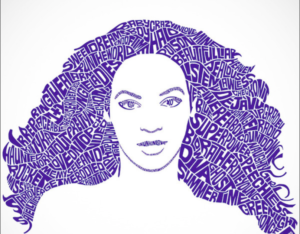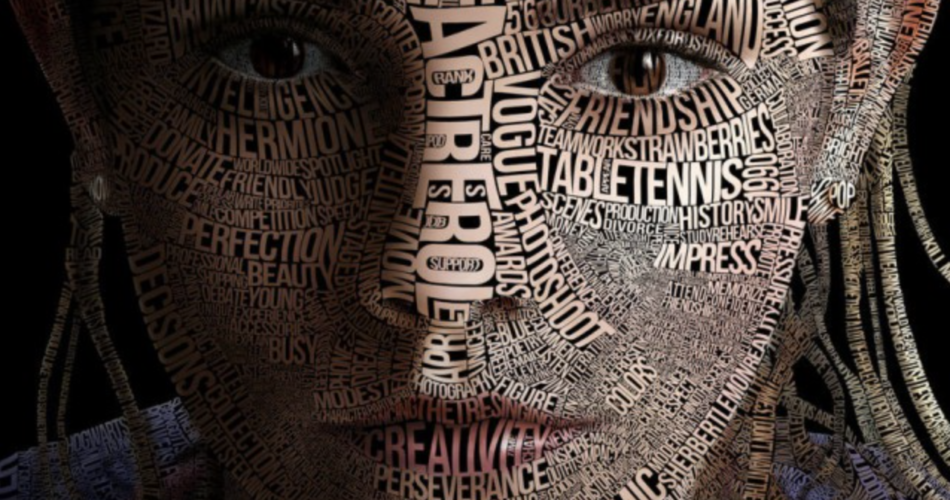Typography portraits, a creative blend of typography design and the craft of portrait-making, have surged in popularity within the realms of design and art. These unique creations, a fusion of text art and portrait art, empower artists to unleash their creativity and convey potent messages. By meticulously selecting words and letters to sketch the shape and features of a subject—be it a person, an animal, or an inanimate object—this article aims to provide an all-encompassing guide to mastering the captivating visual expression of typographic portrait art.

Typography Portraits
The History and Evolution of Typography Portraits
The journey of typography portraits traces back to the early 20th century, gaining momentum with pioneers like Pablo Picasso and Salvador Dali, who melded text with imagery in their groundbreaking works. Yet, it was the digital era that propelled these typographic creations to new heights. The emergence of sophisticated design software paired with the global platform provided by social media, enabled artists worldwide to craft and share their typographic portraits, capturing widespread admiration and attention.
The Elements of a Typography Portrait
Crafting an engaging typography portrait demands a discerning eye for design and a profound grasp of the essential elements at play. The cornerstone of any successful typography design lies in the judicious selection of words and typography letters, which should resonate with the subject’s essence and amplify the artwork’s message. The letters’ size, style, and arrangement are pivotal, influencing the portrait’s overall shape. A thoughtful approach to balance, contrast, and typography flow is vital for achieving a cohesive composition, while the strategic use of color and texture can imbue the piece with depth and intrigue.
Tips for Creating Stunning Typography Portraits
To excel in creating typography portraits, one must embrace practice, experimentation, and meticulous attention to detail. Here are some invaluable tips for crafting mesmerizing typographic portraits:
- Selecting the right subject is crucial: Opt for a subject with a distinctive silhouette and identifiable features, simplifying the process of shaping the typography to match the subject’s form.
- Diversifying fonts can add a layer of contrast and intrigue to your typography portrait. Experimenting with various sizes, styles, and weights can introduce depth and elevate your design.
- Maintaining proper spacing between letters and words is essential for legibility and to ensure a unified composition. Adjust the spacing meticulously to achieve the intended effect.
- Wise use of negative space, the voids around and between letters, is as crucial as the typography itself. Leveraging negative space can enhance the composition and spotlight key elements.
- Seeking inspiration is key: Delve into the works of renowned typographic illustrators and portrait illustrators to glean insights from their techniques and styles. Exploring diverse art forms, such as calligraphy and hand-lettering, can broaden your creative horizons.
Tools and Software for Creating Typography Portraits
In today’s digital landscape, a plethora of tools and software are at your disposal for crafting typography portraits. Here’s a rundown of some popular options:
- Adobe Photoshop stands out as the industry benchmark, offering an extensive array of tools and features for text and image manipulation. It provides precise control over typography placement and boasts advanced editing capabilities.
- Adobe Illustrator shines for vector-based typography portraits, thanks to its robust drawing tools and comprehensive font library, making it a preferred choice for many designers.
- Procreate, available on iPad, offers a fluid digital drawing experience with a wide selection of brushes and an intuitive interface, making it a favorite among digital artists.
- Canva, a user-friendly online design platform, offers pre-designed templates and an extensive font library, making it an excellent choice for beginners or those seeking a quick and straightforward approach to creating typography portraits.
Famous Typography Portrait Artists and Their Work
Several artists have left an indelible mark on the typography portrait landscape with their innovative techniques and distinctive styles. Lex Wilson, known for his intricate lettering and vibrant colors, creates visually arresting and thought-provoking typographic artwork. Rylsee stands out for his playful and whimsical typography portraits, often laced with humor and satire. These artists, among others, continue to expand the horizons of typography portraits, inspiring both budding artists and seasoned designers to delve into this fascinating art form.
Step-by-Step Guide to Creating a Typography Portrait
Creating a typography portrait might seem like a tall order initially, but with a guided approach, anyone can produce stunning results. Here’s a typography portrait tutorial to kickstart your journey in creating captivating typo portraits.
- Choose your subject: Pick a subject that sparks inspiration and boasts a distinctive shape. This could be a person, an animal, or an inanimate object. This crucial first step lays the groundwork for both typographic and graphic design endeavors.
- Gather reference images: Amass reference images of your subject from various angles. These images will act as your roadmap during the creation process, ensuring your typographic portrait remains true to its original form.
- Sketch the outline: Start by lightly sketching your subject’s outline. Concentrate on accurately capturing the essential shape and proportions, setting a solid foundation for your typographic artwork.
- Start adding typography: Begin to fill the outline of your subject with typography. Employ a mix of fonts, sizes, and styles to inject visual interest. Mind the placement and spacing of the letters to achieve a harmonious composition, transforming your sketch into a dynamic typography portrait.
- Refine the details: With the typography set, it’s time to refine your portrait’s details. Enhance the depth and realism of your artwork by adding shading, highlights, and texture, utilizing principles of both typographic and graphic design.
- Finalize the composition: Take a step back to evaluate the overall composition. Make any necessary tweaks to ensure the result is balanced and visually appealing. This step is pivotal in crafting a successful typography poster.
- Add finishing touches: Introduce any final effects or details to complete your typography portrait. Experiment with color, texture, and negative space to add those last enhancements, elevating your piece in the realms of typographic and graphic design.
- Share and showcase your work: Once you’re happy with your typography portrait, it’s time to share it with the world. Whether you post it on social media, enter it into art competitions, or consider selling prints, this is your chance to present your typographic portrait to a broader audience.
Typography Portraits in Advertising and Marketing
Typography portraits have carved a niche in advertising and marketing, thanks to their unique blend of text and imagery. This powerful tool for message conveyance and attention-grabbing is often utilized in branding and marketing campaigns to forge a memorable visual identity. From billboards and magazine covers to social media ads and packaging, typography portraits, often paired with typography quotes, enable businesses to captivate their audience in a visually striking manner.
Typography Portraits in Social Media and Digital Art
Social media platforms have emerged as fertile grounds for typography portraits. Artists and designers showcase their work on Instagram, Pinterest, and Behance, reaching a global audience. The visually captivating nature and emotional resonance of typography portraits often lead them to go viral on social media, marking them as a popular choice for digital illustration. The widespread accessibility and reach of social media have paved new paths for creativity and expression through typography portraits.
Conclusion: Embracing the Power of Words in Visual Expression
Typography portraits present a unique and impactful way to convey ideas, emotions, and messages through the artistic arrangement of words and letters. Merging the art of typography with portrait-making skills, artists craft visually arresting and thought-provoking pieces. Whether for advertising, marketing, social media, or digital art, typography portraits captivate audiences and make a lasting impact. Dive into the world of portraits made of words and unlock your creative potential with typography portraits.
CTA: Discover the limitless possibilities of typography portraits and start creating your own stunning artworks today!

